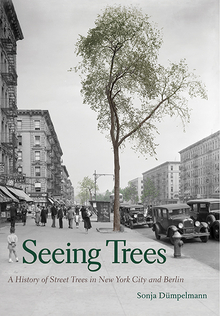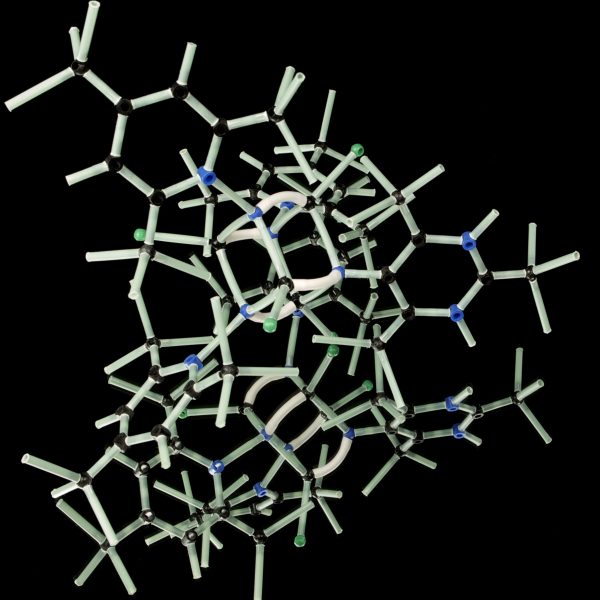Multitasking Trees
Sonja Dümpelmann—
Multitasking Trees
Since their systematic planting throughout the nineteenth and twentieth centuries, street trees have fulfilled various purposes in our cities. They have been considered variously as aesthetic make-up and creators of space; as territorial markers and instruments of defense, emancipation, and empowerment; as sanitizers and air conditioners; as upholders of moral values; as economic engines, scientific instruments, and as ecological habitat. And although street trees are successful multitaskers, which at most times have fulfilled multiple of these purposes, different functions have been considered particularly important at different times.
Cool Trees
In the late nineteenth century when cities were struggling to cope with uncontrolled urban growth and disease, street trees were a means for urban governments to bring nature into dense city centers, rendering the urban fabric more beautiful and civilized, and to cleanse and cool the air. As “ornamental trees” street trees could unify and connect a haphazard urban fabric. A particular species planted as lead species in a neighborhood could also forge an identity and provide the area with a distinct character. As “shade trees” street trees quickly became important to improve public health. For example, in the 1870s, New York physician Stephen Smith promoted street tree planting as a measure that could save up to 5,000 heat-related deaths in the city per year. In early twentieth-century New York City, social reformers and philanthropists realized that street tree planting was especially important in the rundown and overpopulated tenement districts. They formed the Tenement Shade Tree Committee that began to promote and facilitate tree planting along streets in these districts and at public schools.
Research into trees’ cooling functions and gas exchange, and the realization that they absorbed harmful carbon dioxide, also inspired street tree promoters in Berlin. There, street trees’ function in climate mitigation and air filtration became especially pertinent after World War II when much of the city lay in ruins and rubble. The sharp edges of dust particles harmed eyes and respiratory organs, and street trees could alleviate the situation. They could bind dust and provide shade from the glaring summer sun.
Threatened Trees
But Berlin’s reconstruction and the postwar economic boom led to the increase of vehicular traffic causing noise, and soil and air pollution threatening street trees once again. While they turned out to be noise buffers, street trees suffered from the de-icing salt that was washed into soils, and from motor exhaust that polluted the air. New roads also led to the removal of trees, and some people even re-enlivened a nineteenth century argument presumed dead: that trees did not belong in the city. Street trees, they posited, took up space that traffic and real estate needed badly. Street trees were obstacles in urban development and caused too many traffic accidents.
In mid-twentieth-century New York City, some business owners also looked at street trees with disdain. Although studies since then have shown that trees along business streets can promote urban commerce and increase sales, New York business owners were skeptical because they obstructed sidewalk traffic, advertisements, and shop windows. Conflicts around street trees have arisen again and again, not least when they have obstructed street lights and blocked sunlight from entering an apartment; when they have produced smelly flowers and fruit; shed seeds that clung to clothing; and when they have attracted unwanted insects and birds that speckle sidewalks with their droppings.
Ladies Trees
Yet, in the early twentieth century, female New York philanthropists, social reformers, activists, and early design professionals initiated street tree planting campaigns precisely to protect and attract birds to the city. The women also embraced street trees as a means and symbol of empowerment, emancipation, and even resistance. Initiating planting campaigns, they transgressed the separation of private and public spheres, and the binary of male-coded architecture and female-coded nature. Whereas the city and its marketplace were still largely determined and controlled by men, around the turn of the century, trees—considered an element of refinement and civility—both began to symbolize the female transgression of the domestic and public spheres and to be a means and material for this transgression. In Berlin, World War I propelled women to tend to street trees and take over from men. After the war in New York City, women initiated street tree plantings in the honor of fallen American service men.
Empowering Trees
Decades later during the civil rights movement, African-American grassroots activists also began a street tree planting movement to improve inner-city life and reclaim their right to the city. African-American citizens transformed tree-planting and conservation activities into a means of empowerment and emancipation. “Plant-ins” became a tool of community-building as well as a civil right that could be used against ghettoization. One of the things distinguishing the tree planting activities from other civil rights initiatives was not only their grass-roots do-it-yourself and self-help character, but their aesthetic. Trees made a difference, in a visual and spatial sense as well as in the more ephemeral atmospheric sense. Trees could fill the visual and phenomenological gap between top-down policies and the actual experience in the neighborhood.
Lumber Trees
At various moments in time, but in particular in moments of crisis, street trees also became a life-saving material resource turning the city into a forest or orchard that could be harvested. In New York City, the chestnut blight led to an unprecedented large-scale removal of trees from streets and parks in 1912, providing especially poor households with lumber. The coal shortage that hit the city in 1917 upon the United States’ entry into the war again turned street and park trees into a welcome timber supply, as did Dutch elm disease that ravaged city trees beginning in 1933, and the great 1938 and 1944 September hurricanes. In Berlin, street trees provided citizens with firewood during wartime and in the postwar years. In fact, the Western Allies’ order to fell street trees for use as fire wood during the Berlin Blockade 1948/49 incited one of the first ideological battles of the Cold War. Besides lumber, in wartime Berlin street trees also provided vitamin-rich fruit and flowers for infusions. More or less directly, street trees were used as weapons of defense and to achieve autarky.
Truthful Trees
Regardless of the emphasis on specific purposes attributed to street trees at a particular time, trees are true multitaskers which have always responded and adapted to their environment, sometimes developing in unpredictable ways. They have been appreciated for their relative permanence and the durable physical spaces they create, and for the temporary, ephemeral, and more intangible mental spaces and effects they produce.
Sonja Dümpelmann is associate professor of landscape architecture at Harvard’s Graduate School of Design and author or editor/co-editor of several books, including the 2015 John Brinkerhoff Jackson Book Prize–winner Flights of Imagination: Aviation, Landscape, Design.
Further Reading:



























